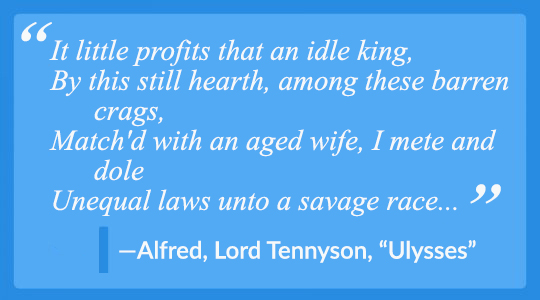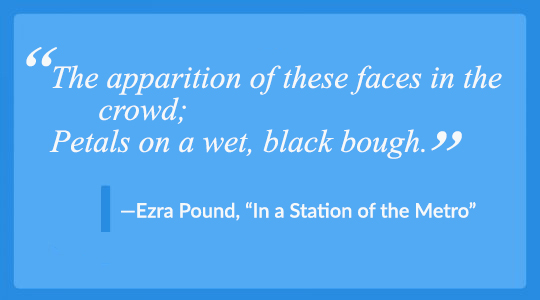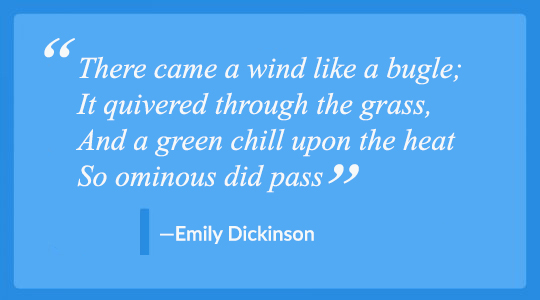How To Start A Poetry Blog For Free
Ever wondered how to write a poem? For writers who want to dig deep, composing verse lets you sift the sand of your experience for new glimmers of insight. And if you're in it for less lofty reasons, shaping a stanza from start to finish can teach you to have fun with language in totally new ways.
Feeling poetry-curious yet? If you're tempted to try your hand at a couple of verses but you're not quite sure where to start, we've got you covered! To demystify the subtle art of writing verse, we chatted with Reedsy editor — and published poet — Lauren Stroh. Without further ado, here's how to write a poem in 8 steps.

Step 1. Brainstorm your starting point
Don't force yourself to write your poem in order, from the first line to the last. Instead, pick a starting point your brain can latch onto as it learns to think in verse.
Your starting point can be a line or a phrase you want to work into your poem, but it doesn't have to take the form of language at all. It might be a picture in your head, as particular as the curl of hair over your daughter's ear as she sleeps, or as capacious as the sea. It can even be a complicated feeling you want to render with precision, or a memory you return to again and again. Think of this starting point as the why behind your poem, your impetus for writing it in the first place.
If you're worried your starting point isn't grand enough to merit an entire poem, stop right there. After all, literary giants have wrung verse out of every topic under the sun, from the disappointments of a post-Odyssey Odysseus to illicitly eaten refrigerated plums.

As Lauren Stroh sees it, your experience is more than worthy of being immortalized in verse.
"I think the most successful poems articulate something true about the human experience and help us look at the everyday world in new and exciting ways."
Step 2. Free-write in prose
Now that you've got a starting point in mind, it's time to put pen to paper (or fingertips to keyboard). But you won't be writing any actual lines just yet. Instead, take this time to delve into the image, feeling, or theme at the heart of your poem, and learn to pin it down with language.
Take 10 minutes and jot down anything that comes to mind when you think of your starting point. You can write in paragraphs, dash off bullet points, or even sketch out a mind map. The purpose of this exercise isn't to produce an outline: it's to generate a trove of raw material, a repertoire of loosely connected fragments to draw upon as you draft your poem in earnest.
The most important part of this free-write? Not censoring yourself. Catch yourself scoffing at a turn of phrase, overthinking a rhetorical device, or mentally grousing, "This metaphor will never make it into the final draft"? Tell that inner critic to hush for now and jot it down anyway. You just might be able to refine that slapdash, off-the-cuff idea into a sharp and poignant line.
Step 3. Choose your poem's form and style
Once your 10 minutes are up, take a look at what your free-write produced. Chances are, you've got a beautiful mess: unruly metaphors, inarticulate emotions, sentences that trail off or change structure midway like grammatical chimeras. That's okay! There's a poem in there somewhere. Your next step? Liberating it from that morass of language.
Think of your free-write a hunk of marble, richly veined with glitter but lacking in form. You're going to take this block and chisel a sculpture out of it. That means figuring out what kind of shape you can discern within it — whether it's classical and restrained, for instance, or naturalistic and free-flowing.

Should you write free verse, or try following more specific "rules," like the rhyme pattern of a sonnet or the syllabic constraints of a haiku? Even if your material begs for a poem without formal restrictions, you'll still have to decide on the texture and tone of your language. Free verse, after all, is as diverse a form as the novel, ranging from the breathless maximalism of Walt Whitman to the cool austerity of H.D. Where, on this spectrum, will your poem fall?
Step 4. Read for inspiration
A poem isn't a nonfiction book or even a historical novel: you don't have to accumulate reams of research to write a good one. That said, a little bit of outside reading can stave off writer's block and keep you inspired throughout the writing process.
Build a short, personalized syllabus around your poem's form and subject. Say you're writing a sensorily rich, linguistically spare bit of free verse about a relationship of mutual jealousy between mother and daughter. In that case, you'll want to read some key Imagist poems, alongside some poems that sketch out complicated visions of parenthood in unsentimental terms.

And if you don't want to limit yourself to poems similar in form and style to your own, Lauren has you covered with an all-purpose reading list:
- The Dream of a Common Language by Adrienne Rich
- Anything you can get your hands on by Mary Oliver
- The poems "First Turn to Me" and "You Jerk You Didn't Call Me Up" by Bernadette Mayer.
- I often gift Lunch Poems by Frank O'Hara to friends who write.
- Everyone should read the interviews from the Paris Review's archives. It's just nice to observe how people familiar with language talk when they're not performing, working, or warming up to write.
Step 5. Start writing for an audience of one — you
With a free-write under your belt and some inspiration close at hand, it's finally time to start the fun part: drafting your poem!
After all the exploratory thinking you've done, you're more than ready to start writing. But the pressure of actually producing verse can still awaken your inner metrophobe (or poetry-fearer). To keep the anxiety at bay, Lauren suggests writing for yourself, not for an external audience.
"I absolutely believe that poets can determine the validity of their own success if they are changed by the work they are producing themselves, if they are challenged by it, if it calls into question their ethics, their habits, or their relationship to the living world. And personally, my life has certainly been changed by certain lines I've had the bravery to think and then write — and those moments are when I've most felt like I've made it."
You might eventually polish your work if you decide to publish your poetry down the line. (And if you do, you can check out this list of magazines accepting poetry submissions to get started.) But as your first draft comes together, treat it like it's meant for your eyes only.
Step 6. Read your poem out loud
A good poem doesn't have to be pretty: maybe an easy, melodic loveliness isn't your aim. It should, however, come alive on the page with a consciously crafted rhythm, whether hymn-like or discordant. To achieve that, read your poem out loud — at first, line by line, and then all together, as a complete text.

Trying out every line against your ear can help you weigh out a choice between synonyms — getting you to notice, say, the watery sound of "glacial", the brittleness of "icy," the solidity of "cold".
Reading out loud can also help you troubleshoot line breaks that just don't feel right. Is the line unnaturally long, forcing you to rush through it or pause in the middle for a hurried inhale? If so, do you like that destabilizing effect, or do you want to literally give the reader some room to breathe?
Step 7. Take a break to refresh your mind
By now, your first draft has come together. It may not be perfect just yet, but congratulations — you've written a poem!
Now, put it away for a while. You've probably read out every line so many times the meaning has leached out of the syllables. So take a week off to read some verse, chip away at your novel, or even muse idly on your next poetic project. Then come back refreshed, because your work isn't done just yet — you still have to revise your poem.
Step 8. Revise your poem
Lauren emphasizes that revising a poem is an open-ended process that requires patience — and a sense of play.
"Have fun. Play. Be patient. Don't take it seriously, or do. Though poems may look shorter than what you're used to writing, they often take years to be what they really are. They change and evolve. The most important thing is to find a quiet place where you can be with yourself and really listen."
Want another pair of eyes on your poem during this process? You have options. You can swap pieces with a beta reader, workshop it with a critique group, or even engage a professional poetry editor like Lauren to refine your work — a strong option if you plan to submit it to a journal or turn it into the foundation for a chapbook.
Want a poetry expert to polish up your verse?
Professional poetry editors are on Reedsy. Sign up for free to meet them!
Learn how Reedsy can help you craft a beautiful book.
If you do decide to fly solo, here's a checklist to work through as you revise:
✅ Hunt for clichés. Did you find yourself reaching for ready-made idioms at any point? Go back to the sentiment you were grappling with and try to capture it in stronger, more vivid terms.
✅ See if your poem begins where it should. Did you take a few lines of throat-clearing to get to the actual point? Try starting your poem further down.
✅ Make sure every line belongs. As you read each line, ask yourself: how does this contribute to the poem as a whole? Does it advance the theme, clarify the imagery, set or subvert the reader's expectations? If you answer with something like, "It makes the poem sound nice," consider cutting it.
Once you've worked your way through this checklist, feel free to brew yourself a cup of tea and sit quietly for a while, reflecting on your literary triumphs. After all, you've taken a poem from the chaotic initial brainstorm to the final coat of polish!
Has this process awakened your inner Wordsworth, or are you happily gamboling back to prose? Either way, we hope you enjoyed playing with poetry — and that you learned something new about your approach to language.
Have you written something you're proud of? Check out our guides on how to publish poetry and how to make a chapbook!
How To Start A Poetry Blog For Free
Source: https://blog.reedsy.com/how-to-write-a-poem/
Posted by: clarknoreed.blogspot.com

0 Response to "How To Start A Poetry Blog For Free"
Post a Comment